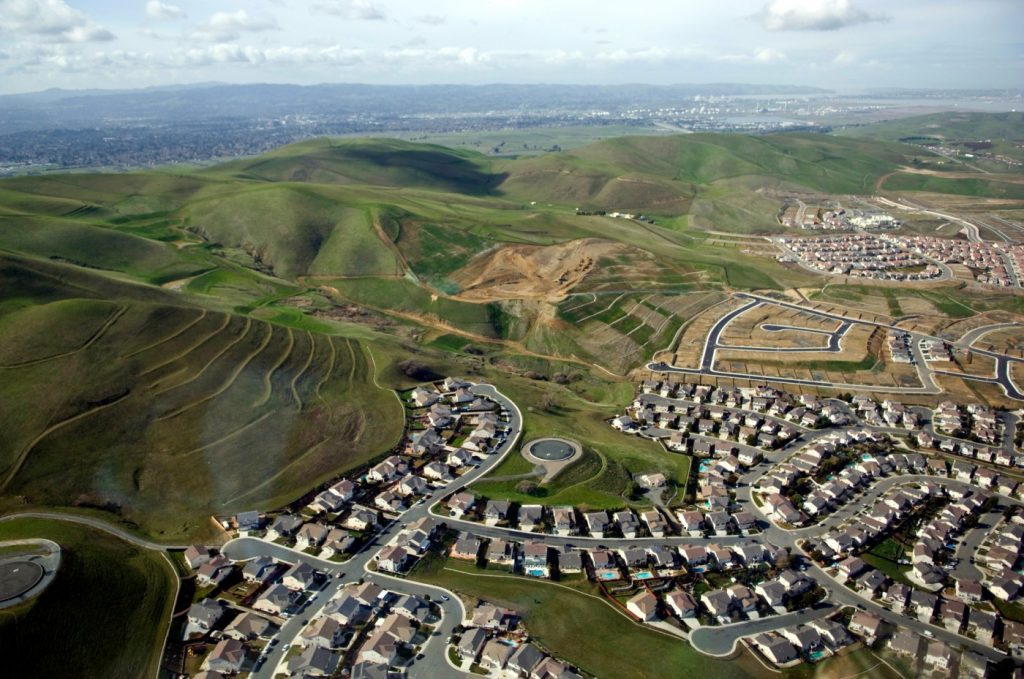The Bay Area’s largest planned housing projects — slated to add tens of thousands of new homes — are clouded with uncertainty heading into next year. Some face delays amid an uneasy post-pandemic economy, while others have been mired in litigation or held up by bureaucracy.
How developers and local officials confront those challenges could be crucial to alleviating the region’s deepening housing shortage. Here are five of the major Bay Area developments with the most at stake in 2024.
An “aggressive” new timeline for the Concord Naval Weapons Station project
After cycling through three different developers over the past two decades, Concord hopes the latest multibillion-dollar plan to transform the former Concord Naval Weapons Station into a new master-planned community with more than 10,000 homes signals the project is finally on the road to completion.
Until recently, the push to develop one of the Bay Area’s most ambitious projects in one of its most sought-after locations — including millions of square feet of schools, offices, shops and restaurants — has been derailed by a litany of labor disputes, cost concerns and allegations of backroom deals.
In September, the city inked an initial agreement with Brookfield Properties to outline project timelines and other details in a term sheet, which the City Council could approve early next year. The New York-based developer aims to then work with city officials to have a finalized plan by January 2026.
While acknowledging two years is an “aggressive timeline” for preparing a project of this scope, Brookfield officials told this news organization earlier this year they’re confident the plan will stick this time around.
Louis Mirante, vice president of public policy at the Bay Area Council, a regional pro-business group, said the biggest challenge for megaprojects like the weapons station is financing as borrowing costs have exploded. But he said simplifying the byzantine local approval process for large housing projects would slash costs and attract more investment as construction timelines become more certain.
“Right now, it’s really difficult to demonstrate you can make a return on 8% interest rates,” Mirante said.
A view of ammunition bunkers is seen during a community and city employee tour of the Concord Naval Weapons Station in Concord, Calif., on Wednesday, May 23, 2018. (Jane Tyska/Bay Area News Group) (Jane Tyska/Bay Area News Group)
Will Google’s San Jose megadevelopment break ground?
This year, Google was supposed to start construction on its massive mixed-use neighborhood with thousands of homes and offices in downtown San Jose. But in February, the tech giant revealed it was “assessing how to best move forward” with the project.
The news set off a flurry of speculation Google might back out of the long-planned project as the company began laying off workers as construction and financing costs soared, and questions emerged about the pandemic recovery of the Bay Area’s urban cores.
Google maintains it’s committed to the Downtown West development, which is expected to take many years to build, though it has yet to provide an updated timetable. Planned for the formerly industrial Diridon Station neighborhood, the development is still expected to include up to 4,000 homes, more than 7 million square feet of office space for 20,000 Google employees and dozens of shops and restaurants.
“We believe in the people who live here, who work here and are committed to being here in San Jose,” Ruth Porat, president and chief investment officer with Google parent company Alphabet, said in September.
Gathering areas in Google’s Downtown West mixed-use neighborhood near the Diridon train station in downtown San Jose, concept.(Google LLC) (Google LLC)
But in November, citing “current market conditions,” the company announced it was parting ways with its real estate partner for Downtown West and three other huge South Bay projects, together totaling as many as 15,000 new homes. The other developments include two planned mixed-use projects in Mountain View, dubbed Middlefield Park and North Bayshore, and a possible housing project in the Moffet Park area of Sunnyvale. Google said it’s still pushing ahead with all four projects.
Elsewhere in the South Bay, the long-delayed Related Santa Clara mixed-use project, slated to add almost 1,700 apartments near Levi’s Stadium, could finally break ground in 2024. In Cupertino, preliminary construction on the redevelopment of Vallco Mall, planned for more than 2,600 homes and more than 6 million square feet of office space, is set to resume early next year.
Voters could decide Silicon Valley billionaires’ vision for new Solano County city
This coming November, Solano County voters may decide the fate of Silicon Valley billionaires’ utopian vision for a new city that would add tens of thousands of new homes to rural farmland between Travis Air Force Base and the Sacramento River.
California Forever, funded by a handful of uber-wealthy tech executives and investors, including Marc Andreessen, spent at least $800 million in recent years quietly snapping up properties until its plans were revealed this summer. Seeking more parcels, the company is now suing local ranchers, accusing them of conspiring to overcharge for their properties out of “endless greed.”
While some neighbors view the project as a pure land grab sure to destroy the area’s rural character, backers describe it as an opportunity to build an affordable and environmentally sustainable community that would be a “prosperous economic engine” for the county.
California Forever aims to continue selling county residents on the plan through a series of town hall meetings next year and said it will reveal more details about the decades-long project in January. The company then plans to collect thousands of signatures to put an initiative on the November ballot that would change local zoning regulations and allow the development to move forward.
Even if the measure fails, California Forever Chief Executive Jan Sramek told this news organization earlier this month “there are other ways to proceed” but declined to elaborate.
Artist renderings of a purported utopian plan, building a dream city in rural Solano County by a company, Flannery Associates, made up of ultra-wealthy Silicon Valley investors. (Courtesy of California Forever)
Developer lawsuits may hold up redevelopment of Treasure Island
The ongoing redevelopment of Treasure Island into a high-rise neighborhood with more than 8,000 housing units hit a potential snag this year when the real estate companies behind the development sued each other over their future returns from the former naval base project.
It’s unclear whether the legal wrangling pitting Sonoma-based Kenwood Investments against Stockbridge Capital Group and Wilson Meany in San Francisco could jeopardize the project’s 2026 completion date. But Sam Singer, a spokesperson for Kenwood, said in an email it’s “likely that construction will be impacted by the litigation.”
At issue in the lawsuits is reconciling how pandemic delays and other recent economic challenges have increased costs and depressed expected revenues to be split among the companies.
Stockbridge Capital Group did not immediately respond to a request for comment.
Still, the project, slated to include 300,000 square feet of retail space, 500 hotel rooms and 300 acres of open space, continues to take shape just west of the Bay Bridge. The 22-story Tidal House, the first high-rise completed on the island, is set to open for occupancy next year.
SAN FRANCISCO, CA – MAY 13: Treasure Island, Yerba Buena Island, top, and the Bay Bridge are seen from this drone view in San Francisco, Calif., on Thursday, May 13, 2021. (Jane Tyska/Bay Area News Group)
Three towering apartment and office buildings proposed for suburban Menlo Park
Three apartment and office towers as tall or taller than the Statue of Liberty may soon soar above suburban Menlo Park. And much to neighbors’ dismay, city officials could be helpless to halt construction.
Related Articles
A unique roommate finder helps Bay Area seniors stay in homes
Despite billions spent, new data shows almost a third of the nation’s homeless now live in California
State plans pricey fixes to California’s broken insurance market. Are homeowners on board?
A year in, San Jose’s mayor doubts he can hit his homeless housing goals — even with an extension
Share the Spirit: After years in the foster system, a young woman gets a room of her own
To push through the proposal for the former Sunset Magazine headquarters on leafy Willow Road, an upstart local development company seeks to take advantage of an until-recently little-known state law dubbed the “builder’s remedy.” While legal questions remain, the rule is designed to force cities that fall behind on their state-mandated housing plans to automatically accept projects of virtually any size.
Even though Menlo Park finally got state approval on its plan this month, local officials have acknowledged the project may still be able to go through.
An earlier proposal filed over the summer pointed to one tower, but a new plan submitted this month sketches out a vision for three high-rises at 80 Willow Road. The buildings would include more than 800 residential units, 161 of them affordable, along with 300,000 square feet of office space,15,000 square feet of retail and restaurant space and a hotel. Each high-rise would be more than 300 feet tall, with the largest at 421 feet.
A patio area is surrounded by lush vegetation at Sunset Magazine in Menlo Park, Calif. on Monday, April 29, 2013. (Gary Reyes/ Bay Area News Group) (Gary Reyes/ Bay Area News Group)


